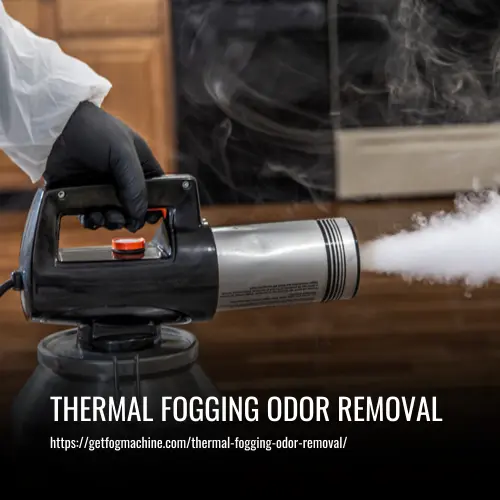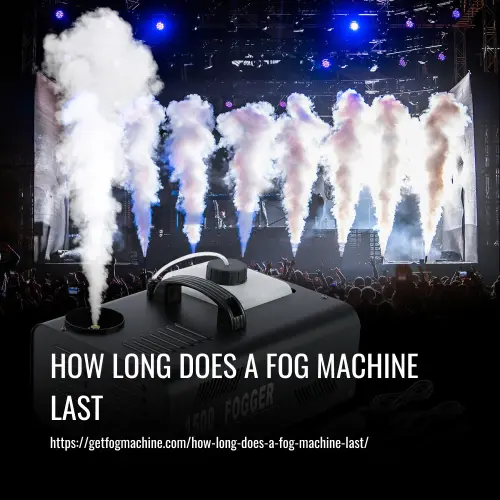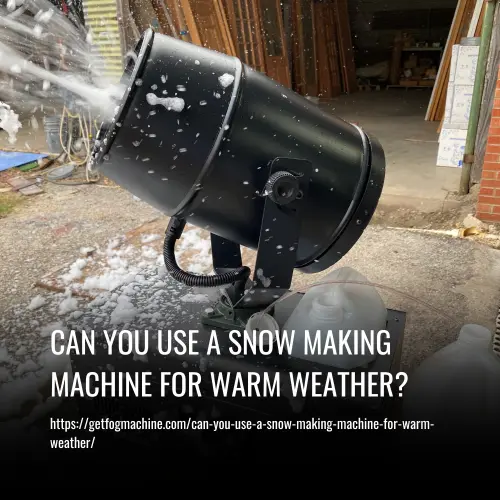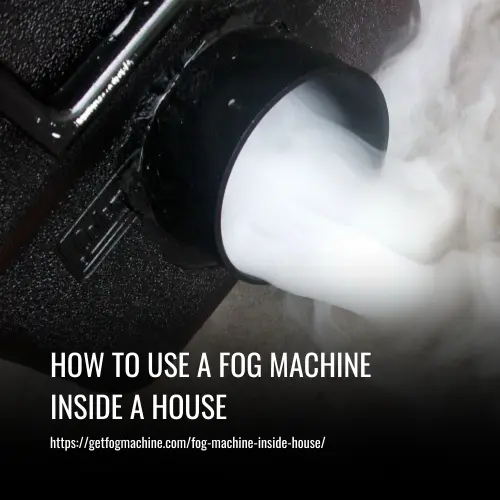Fog Machine vs Smoke Machine: What’s the Difference?
This post contains affiliate links. As an Amazon Associate, we earn from qualifying purchases.
Fog machines and smoke machines both create atmospheric effects, but they differ in how they produce and disperse their effects. While smoke machines generate heated smoke that rises and spreads throughout the room, fog machines produce cold liquid particles that create a low-flying fog. Smoke machines are ideal for use in shows, concerts, and parties, and for creating spooky effects.
Fog machines, on the other hand, are great for enhancing stage productions and creating a dense cloud close to the ground. Understanding these key differences can help you make an informed decision on which type of machine to use for your specific application.
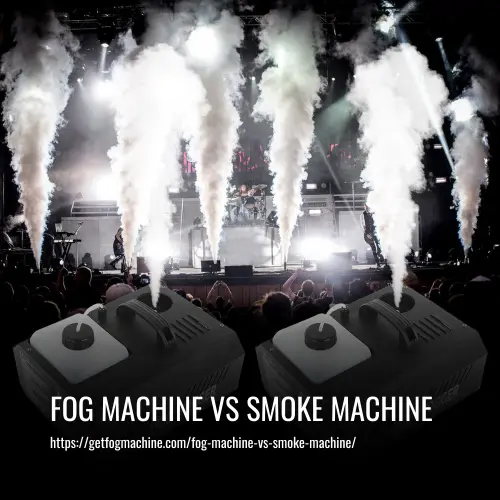
What Is A Fog Machine
A fog machine is a device that vaporizes fog fluid and expels it into the air. This creates thick, visually impressive clouds of fog that can be seen from a distance, adding a dramatic and atmospheric effect. Fog machines are commonly used in theatrical productions, music videos, and special events to simulate smoke and create an instant ambiance.
However, compared to haze machines, the fog from fog machines dissipates quickly and is less consistent in its coverage. Fog machines are ideal for creating quick and visually striking effects, making them a popular choice for creating spooky or otherworldly atmospheres.
What Is a Smoke Machine
A smoke machine is a special effects device that uses a special fluid to produce thick clouds of white smoke. It is often controlled remotely, allowing for customization of the volume and duration of the smoke. The effect created by a smoke machine is similar to that of low fog machines but with one key difference. The smoke produced by a smoke machine is heated and rises, eventually dissipating throughout the room.
On the other hand, low fog machines produce cold liquid particles that stay close to the ground, creating a dense cloud effect. Smoke machines are commonly used in concerts, theater productions, music videos, and other professional applications to enhance the visual experience and create an extra level of ambiance.
What Is The Difference Between Fog Machine And Smoke Machine
Smoke and fog may appear similar at first glance, but they are actually made up of different components. Smoke consists of small and light solid carbon particles that are dispersed in the air by wind. In contrast, fog is composed of tiny ice crystals. This distinction affects their behavior and usage.
1. Maintenance
Smoke machines require less maintenance compared to fog machines. Smoke liquid does not degrade or shrink in volume like dry ice in fog machines. As a result, smoke machines can generate more smoke per unit of liquid volume. However, smoke machines can be more challenging to clean up after use, leaving behind stains due to the chemicals in the liquid.
2. Uses
Smoke machines are commonly used in the film industry to simulate fires, while fog machines are more prevalent in the theater industry. Theatrical productions benefit from fog machines as they create a low-lying fog that enhances the stage atmosphere without straining the viewers’ eyes or neck.
3. Safety
In terms of safety, fog machines are considered safer than smoke machines. The dry ice used to create fog is non-toxic, while smoke machines use glycol, a potentially toxic substance. The glycol used in smoke machines can pose a health risk, particularly for individuals with respiratory issues. The fog produced by dry ice is completely harmless.
4. Outdoor and Indoor Usage
Fog machines are commonly used indoors, while smoke machines are less suitable for indoor use. Smoke can fill an entire room and may damage the flooring. Additionally, smoke detectors may be triggered by the presence of smoke, causing false alarms.
How Do Fog and Smoke Machines Work
Fog and smoke machines are popular devices used to create atmospheric effects and enhance lighting setups in various settings, including stage productions, music videos, and dance floors. While these machines serve similar purposes, there are a few key differences in how they operate.
1. Atomization of Special Fluids
Both fog and smoke machines utilize a liquid-based device to atomize or vaporize a special fluid. This process involves forcing the liquid under high pressure through a heated pipe. The heated element is present in most machines, although there are also water and oil-based fluids available depending on the device.
2. Creation of Clouds and Effects
Once the fluid is atomized, it is pushed into the air, creating the desired effect. Fog machines typically produce a dense cloud of mist that resembles natural fog, while smoke machines generate a thicker, more opaque smoke-like effect. Some higher-grade fog machines use dry ice to create a low-lying fog effect that stays close to the ground.
3. Safety Considerations
The liquids used in fog and smoke machines are generally safe to breathe in moderation. However, it is important not to overdo the special effects to ensure a healthy environment. Additionally, both fog and smoke are safe to use around electrical equipment, but regular cleaning of the gear is necessary to maintain the highest safety standards.
The Types of Fog Machines
There are two common types of fog machines: dry ice and cryogenic. Dry ice fog machines use a combination of dry ice and water to produce the fog effect, but this effect has a limited lifespan. On the other hand, cryogenic fog machines use a liquid, such as liquid CO2, to create fog, which lasts longer.
Both types of fog machines create a dense opaque cloud near the ground, perfect for creating special effects in various settings. Whether for weddings, theater productions, or music videos, understanding the types of fog machines can help you make an informed decision when choosing the right machine for your needs.
When to Use a Fog Machine
A fog machine is a popular choice for special effect productions, music videos, and creating a romantic ambiance on the dance floor. It is commonly used by DJs to enhance the atmosphere and create a stunning visual effect.
Fog machines produce a dense cloud of smoke particles that can be controlled using a remote control. They are versatile, easy to use, and can create a dramatic and exciting atmosphere for various events. Whether it’s a wedding entrance, a music video shoot, or a dance party, a fog machine is an essential tool for adding a touch of magic and visual appeal.
The Types of Smoke Machines
There are different types of smoke machines available on the market. These machines create a dense, thick white cloud that rises and spreads throughout a room. They are often confused with fog machines, but the two have distinct differences. While fog machines produce low-lying fog, smoke machines emit heated gas, causing the smoke to rise.
Smoke machines require special smoke fluid to create the desired effect. These machines are commonly used in theatrical productions, music videos, and other professional applications where a thick cloud of smoke is needed. It is important to understand the different types of smoke machines available in order to make an informed decision and achieve the desired stage effects or special effects for any event.
When to Use a Smoke Machine
A smoke machine is typically used in shows, concerts, and spooky settings to create a dense cloud of smoke or mist. It is also commonly used in fire stations for training purposes, where they simulate smoke-filled environments using oil-based liquids.
The smoke created by a smoke machine consists of small particles suspended in the air, which can enhance the atmosphere and lighting effects on a dance floor or stage. The use of a smoke machine can add an extra level of excitement and visual impact to a performance or event.
Price Comparison: Fog Machine vs. Smoke Machine
When it comes to choosing between a fog machine and a smoke machine, price is often a determining factor. Understanding the price differences and what factors can affect the cost can help you make an informed decision.
Differences in Price
Generally, smoke machines are more affordable compared to low-fog machines. Smoke machines can cost as low as $60 and upwards, depending on the quality and features. On the other hand, low-fog machines typically start at around $150, making them more expensive options.
Factors Affecting Price
Several factors can impact the price of both fog machines and smoke machines:
1. Wattage: Machines with higher wattage might be more expensive due to their increased power and performance capabilities.
2. Lighting Features: Some machines come equipped with built-in lights, which can enhance the stage effects and add an extra level of ambiance. Machines with advanced lighting features may cost more.
3. Remote Control Features: Machines that offer remote control capabilities, such as adjusting fog intensity, setting timers, or moving the fog direction, tend to be priced higher.
4. Dry Ice Usage: Some machines use dry ice to create a dense cloud of smoke or fog. Incorporating dry ice technology can increase the cost of the machine.
Advantages of Fog Machine
Fog machines are a popular choice for creating a dense cloud of smoke-like fog in various settings. These machines have several advantages:
1. Versatility
Fog machines are incredibly versatile and can be used in a wide range of applications, including concerts, theater productions, dance floors, and special events. They add an extra level of atmosphere and enhance the visual effects of lighting beams and stage lights.
2. Ease of Use
Fog machines often come with remote control, making them easy to operate from a distance. This allows for convenient control of the fog output and timing during performances or events.
3. Safe to Use
Fog machines use water-based fluids, which produce a fine mist of liquid particles rather than solid particles. This makes them safe to use around smoke detectors and minimizes the risk of oily residue or damage to equipment.
Advantages of Smoke Machine
Smoke machines are designed to produce thick smoke effects that can add drama and tension to live theater, concerts, and special events. They offer the following advantages:
1. Dramatic Effects
Smoke machines produce a dense cloud of smoke that enhances the visual impact of stage performances, pyrotechnic displays, or spooky atmospheres. This adds an element of excitement and captivates the audience.
2. Lower Risk of Residue
Smoke machines typically use specialized smoke fluid that produces clean and dissipating smoke. This reduces the risk of leaving behind an oily residue on surfaces or costumes, allowing for a cleaner performance.
3. Versatile Effects
Smoke machines offer a wide range of smoke effects, including colored smoke, bursts, and puffs. This allows for creative and dynamic stage effects that enhance the overall production value.
Disadvantages of Fog Machine
Here are some disadvantages of fog machines.
1. Limited fog production at higher settings
One disadvantage of low fog machines is that they may not produce enough fog when the fog dial is set above 4. This can be frustrating for users who require a denser fog effect or need to cover a larger area.
2. Shorter running time
Compared to smoke or haze machines, low fog machines typically have a shorter running time. This means that they may require frequent refilling or maintenance during longer performances or events.
Disadvantages of Smoke Machine
Here are some disadvantages of smoke machines.
1. Limited visibility
One disadvantage of smoke machines is that they can create a thick cloud of smoke that may obstruct visibility, especially in small or enclosed spaces. This can be a safety concern for performers or audience members as it may affect their ability to see clearly.
2. Longer warm-up time
Smoke machines usually require a longer warm-up time compared to other machines. This can be a drawback in situations where quick setup and activation are necessary, such as during live performances or time-sensitive events.
3. Residue and cleanup
Smoke machines often leave behind a residue or oily residue on surfaces and equipment. This can require extra time and effort for cleanup and maintenance after each use.
How to Use Fog Machines and Smoke Machines Correctly and Safely
Using fog machines and smoke machines correctly and safely is crucial to ensuring a successful event without risks. These atmospheric effects machines are commonly used in stage productions, music videos, and other professional applications to create a captivating ambiance. While fog machines and smoke machines provide similar effects, they work differently and require specific usage guidelines.
1. Understanding the Differences
Fog machines create a thick, dense cloud of fog using oil-based fluids or dry ice. On the other hand, smoke machines produce lighter, translucent smoke made of tiny particles. The key difference lies in their particle size and density.
2. Consider the Venue
Before using a fog or smoke machine, evaluate the venue’s size, ventilation, and fire safety measures. Ensure it is compatible with these effects and won’t trigger smoke detectors unnecessarily.
3. Select the Appropriate Machine
Choose the right machine based on your specific needs. For longer events, such as concerts, opt for smoke machines that can provide a continuous flow of smoke without frequent refills. Haze machines are ideal for dramatic visibility changes but may require frequent servicing due to nitrogen exhaustion. Low-fog machines emit a higher volume of fog for a longer-lasting effect using less nitrogen.
4. Follow Safety Guidelines
Always prioritize safety when using fog or smoke machines. Place them on a stable surface, away from flammable objects. Make sure the area is well-ventilated to prevent fog or smoke from becoming too dense.
5. Provide Safety Training
If operating these machines in a professional setting, ensure all staff members receive proper safety training. Educate them on fire safety protocols, how to handle the machines correctly, and emergency procedures.
6. Use Remote Control for Safety
For increased safety, use a remote control to operate the fog or smoke machine. This allows the operator to stay at a safe distance and avoid exposure to the effects.
FAQs
Fogging pumps produce ultra-small droplets, approximately 1-10 microns while misting pumps produce slightly larger droplet sizes, approximately 10-100 microns.
Fluid-based fog machines work by rapidly heating a mixture of water and glycol, producing a vapor. The vapor mixes with cooler air to form fog.
Smoke is formed when particles of dust get mixed with air, while fog is formed when water vapors condense to form liquid water droplets that hang in the air.
Haze machines produce a light, low-density cloud using a mixture of glycol and water. They are commonly used in dance clubs for backlighting effects and on stage to create an overcast look for outdoor concert performances.
Low-fog machines discharge the smallest droplets of fog possible, ideal for spaces with low ceilings or hard surfaces. They use high-pressure pumps to produce smaller particles that dissipate quickly into the atmosphere. The height of these machines can often be adjusted, making them suitable for both small wisps and large volumes of fog.
Conclusion
When it comes to choosing between a fog machine and a smoke machine, it is important to consider the desired effects and the specific requirements of the event or production. Fog machines are versatile and can create a thick, dense fog that is perfect for creating a mysterious atmosphere and enhancing lighting effects. They are ideal for dance floors, stage productions, and music videos, where a solid cloud of fog can add drama and impact.
On the other hand, smoke machines are better suited for creating a lighter, haze-like effect. They produce a finer mist of particles, which can be easily dispersed and remain in the air for a longer period of time. This makes smoke machines perfect for creating beams of light and adding an extra level of visual appeal.
Both fog machines and smoke machines have their own unique features and benefits. It is important to consider factors such as particle size, safety training, and the type of fluid used to make an informed decision.


